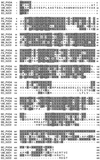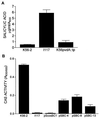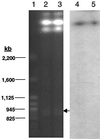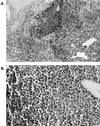Role of ornibactin biosynthesis in the virulence of Burkholderia cepacia: characterization of pvdA, the gene encoding L-ornithine N(5)-oxygenase
- PMID: 10456885
- PMCID: PMC96763
- DOI: 10.1128/IAI.67.9.4443-4455.1999
Role of ornibactin biosynthesis in the virulence of Burkholderia cepacia: characterization of pvdA, the gene encoding L-ornithine N(5)-oxygenase
Abstract
Burkholderia cepacia is a frequent cause of respiratory infections in cystic fibrosis patients. B. cepacia has been shown to produce at least four siderophores which may play a role in the virulence of this organism. To characterize genes involved in the synthesis of siderophores, Tn5-OT182 mutants were isolated in strain K56-2, which produces two siderophores, salicylic acid (SA) and ornibactins. Two mutants were characterized that did not produce zones on Chrome Azurol S agar in a commonly used assay to detect siderophore activity. These mutants were determined to produce sevenfold more SA than K56-2 yet did not produce detectable amounts of ornibactins. These mutants, designated I117 and T10, had a transposon insertion in genes with significant homology to pyoverdine biosynthesis genes of Pseudomonas aeruginosa. I117 contained an insertion in a pvdA homolog, the gene for the enzyme L-ornithine N(5)-oxygenase, which catalyzes the hydroxylation of L-ornithine. Ornibactin synthesis in this mutant was partially restored when the precursor L-N(5)-OH-Orn was added to the culture medium. T10 contained an insertion in a pvdD homolog, which is a peptide synthetase involved in pyoverdine synthesis. beta-Galactosidase activity was iron regulated in both I117 and T10, suggesting that the transposon was inserted downstream of an iron-regulated promoter. Tn5-OT182 contains a lacZ gene that is expressed when inserted downstream of an active promoter. Both I117 and T10 were deficient in uptake of iron complexed to either ornibactins or SA, suggesting that transposon insertions in ornibactin biosynthesis genes also affected other components of the iron transport mechanism. The B. cepacia pvdA homolog was approximately 47% identical and 59% similar to L-ornithine N(5)-oxygenase from P. aeruginosa. Three clones were identified from a K56-2 cosmid library that partially restored ornibactin production, SA production, and SA uptake to parental levels but did not affect the rate of (59)Fe-ornibactin uptake in I117. A chromosomal pvdA deletion mutant was constructed that had a phenotype similar to that of I117 except that it did not hyperproduce SA. The pvdA mutants were less virulent than the parent strain in chronic and acute models of respiratory infection. A functional pvdA gene appears to be required for effective colonization and persistence in B. cepacia lung infections.
Figures







Similar articles
-
Cloning and nucleotide sequence of the pvdA gene encoding the pyoverdin biosynthetic enzyme L-ornithine N5-oxygenase in Pseudomonas aeruginosa.J Bacteriol. 1994 Feb;176(4):1128-40. doi: 10.1128/jb.176.4.1128-1140.1994. J Bacteriol. 1994. PMID: 8106324 Free PMC article.
-
Regulation of ornibactin biosynthesis and N-acyl-L-homoserine lactone production by CepR in Burkholderia cepacia.J Bacteriol. 2001 Apr;183(7):2212-8. doi: 10.1128/JB.183.7.2212-2218.2001. J Bacteriol. 2001. PMID: 11244059 Free PMC article.
-
Quorum sensing in Burkholderia cepacia: identification of the LuxRI homologs CepRI.J Bacteriol. 1999 Feb;181(3):748-56. doi: 10.1128/JB.181.3.748-756.1999. J Bacteriol. 1999. PMID: 9922236 Free PMC article.
-
Insights into the role of extracellular polysaccharides in Burkholderia adaptation to different environments.Front Cell Infect Microbiol. 2011 Dec 15;1:16. doi: 10.3389/fcimb.2011.00016. eCollection 2011. Front Cell Infect Microbiol. 2011. PMID: 22919582 Free PMC article. Review.
-
Extracytoplasmic Function Sigma Factors Governing Production of the Primary Siderophores in Pathogenic Burkholderia Species.Front Microbiol. 2022 Feb 24;13:851011. doi: 10.3389/fmicb.2022.851011. eCollection 2022. Front Microbiol. 2022. PMID: 35283809 Free PMC article. Review.
Cited by
-
Pseudobactin biogenesis in the plant growth-promoting rhizobacterium Pseudomonas strain B10: identification and functional analysis of the L-ornithine N(5)-oxygenase (psbA) gene.J Bacteriol. 2000 Nov;182(21):6233-8. doi: 10.1128/JB.182.21.6233-6238.2000. J Bacteriol. 2000. PMID: 11029447 Free PMC article.
-
Attenuated virulence of a Burkholderia cepacia type III secretion mutant in a murine model of infection.Infect Immun. 2003 Mar;71(3):1405-15. doi: 10.1128/IAI.71.3.1405-1415.2003. Infect Immun. 2003. PMID: 12595458 Free PMC article.
-
A genetic locus required for iron acquisition in Mycobacterium tuberculosis.Proc Natl Acad Sci U S A. 2006 Feb 14;103(7):2069-74. doi: 10.1073/pnas.0507924103. Epub 2006 Feb 3. Proc Natl Acad Sci U S A. 2006. PMID: 16461464 Free PMC article.
-
Harnessing hypoxia: bacterial adaptation and chronic infection in cystic fibrosis.FEMS Microbiol Rev. 2025 Jan 14;49:fuaf018. doi: 10.1093/femsre/fuaf018. FEMS Microbiol Rev. 2025. PMID: 40312783 Free PMC article. Review.
-
Do Global Regulators Hold the Key to Production of Bacterial Secondary Metabolites?Antibiotics (Basel). 2019 Sep 23;8(4):160. doi: 10.3390/antibiotics8040160. Antibiotics (Basel). 2019. PMID: 31547528 Free PMC article. Review.
References
-
- Atkin C L, Neilands J B. Rhodotorulic acid, a diketopiperazine dihydroxamic acid with growth-factor activity. I. Isolation and characterization. Biochemistry. 1968;7:3734–3739. - PubMed
-
- Ausubel F M, Brent R, Kingston R E, Moore D D, Seidman J G, Smith J A, Struhl K, editors. Current protocols in molecular biology. Vol. 1. New York, N.Y: John Wiley & Sons, Inc.; 1989.
-
- Braun V, Gunter K, Hantke K. Transport of iron across the outer membrane. Biol Metals. 1991;4:14–22. - PubMed
-
- Cantin, A. M., and D. E. Woods. Prolastin suppresses lung damage, inflammation and bacterial proliferation in a model of chronic Pseudomonas aeruginosa lung infection. Am. Rev. Res. Crit. Care Med., in press. - PubMed
Publication types
MeSH terms
Substances
Associated data
- Actions
- Actions
- Actions
LinkOut - more resources
Full Text Sources
Molecular Biology Databases
Research Materials

